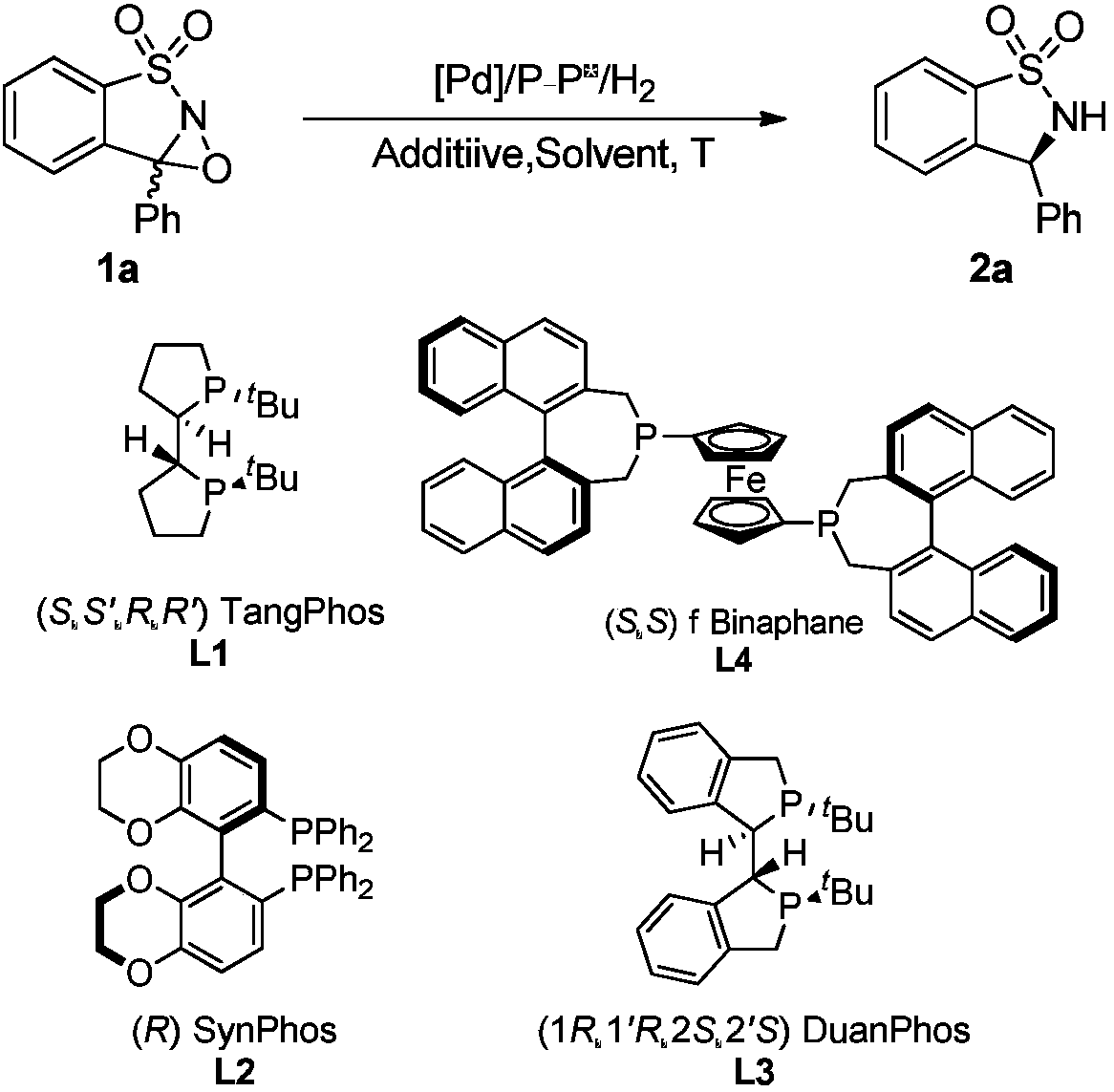A method for palladium catalyzed asymmetric hydrogenolysis and racemization of oxaziridine to synthesize chiral amines
An oxaziridine and asymmetric technology is applied in the field of synthesizing chiral sulfonamide by catalytic hydrogenolysis and racemization of oxaziridine to achieve the effects of high reactivity and enantioselectivity, convenient preparation and convenient separation
- Summary
- Abstract
- Description
- Claims
- Application Information
AI Technical Summary
Problems solved by technology
Method used
Image
Examples
Embodiment 1
[0032] Embodiment 1: optimization of conditions
[0033] Put palladium trifluoroacetate (3 mol% of the substrate amount) and chiral phosphine ligand (3.3 mol% of the substrate amount) into the reaction bottle, add 1 ml of acetone after nitrogen replacement, and stir at room temperature for 1 hour. Concentrate in vacuo then, add 3 milliliters of dichloromethane under nitrogen, this solution is transferred in the reaction kettle that has put substrate 1a (51.8 mg, 0.2 mmol) and camphorsulfonic acid (10mol% of substrate consumption) in advance, pass Inject hydrogen gas at 600psi, and react at 50°C for 20 hours. Slowly release hydrogen, remove the solvent, and directly separate the pure product by column chromatography. The reaction formula and ligand structure are as follows:
[0034]
[0035] The yield was determined from the reaction crude product with 1,3,5-trimethoxybenzene as the internal standard 1 H NMR to determine, the enantiomeric excess of the product was determin...
Embodiment 2
[0040] Example 2: Synthesis of various chiral sulfonamides by palladium catalyzed asymmetric hydrogenolysis 2
[0041] Drop into palladium trifluoroacetate (3 mol% of substrate consumption) and (S, S, R, R)-TangPhos (3.3mol% of substrate consumption) in reaction bottle, add 1 milliliter of acetone after nitrogen displacement, room temperature stirs 1 Hour. Concentrate in vacuo then, add 3 milliliters of dichloromethane under nitrogen, this solution is transferred to the reaction kettle that has put substrate (0.2 mmol) and L-CSA (10mol% of substrate consumption) in advance, feeds hydrogen to 600psi , React at 50°C for 15-24 hours, and slowly release hydrogen. After removing solvent, direct column chromatography separates and obtains pure product, and reaction formula is as follows:
[0042]
[0043] The yield is the separation yield, and the enantiomeric excess of the product is determined by chiral liquid chromatography, see Table 2.
[0044]Table 2. Palladium-catalyzed...
Embodiment 3
[0048] Example 3: Synthesis of various chiral sulfonamides by palladium-catalyzed asymmetric hydrogenolysis 4
[0049] Drop into palladium trifluoroacetate (3 mol% of substrate consumption) and (S, S, R, R)-TangPhos (3.3mol% of substrate consumption) in reaction bottle, add 1 milliliter of acetone after nitrogen displacement, room temperature stirs 1 Hour. Concentrate in vacuo then, add 3 milliliters of dichloromethane under nitrogen, this solution is transferred to the reaction kettle that puts substrate (0.2 mmol) and L-CSA (10mol% of substrate consumption) in advance, feeds hydrogen to 1000psi , React at 70°C for 15-24 hours, slowly release hydrogen. After removing solvent, direct column chromatography separates and obtains pure product, and reaction formula is as follows:
[0050]
[0051] The yield is the isolated yield, and the enantiomeric excess of the product is determined by chiral liquid chromatography, see Table 3.
[0052] Table 3. Synthesis of various chira...
PUM
 Login to View More
Login to View More Abstract
Description
Claims
Application Information
 Login to View More
Login to View More - R&D
- Intellectual Property
- Life Sciences
- Materials
- Tech Scout
- Unparalleled Data Quality
- Higher Quality Content
- 60% Fewer Hallucinations
Browse by: Latest US Patents, China's latest patents, Technical Efficacy Thesaurus, Application Domain, Technology Topic, Popular Technical Reports.
© 2025 PatSnap. All rights reserved.Legal|Privacy policy|Modern Slavery Act Transparency Statement|Sitemap|About US| Contact US: help@patsnap.com



